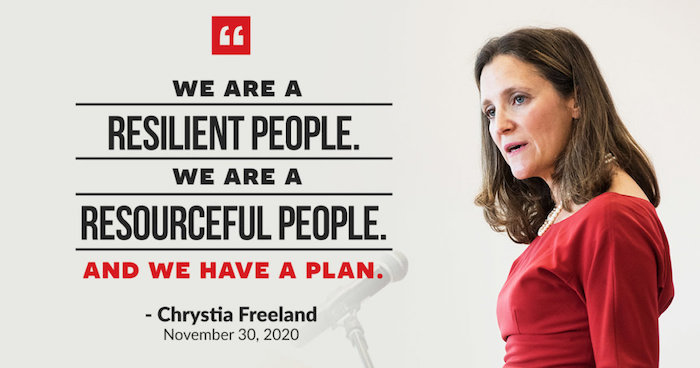
Feds’ fall economic statement suggests engineering opportunities
December 3, 2020
By CCE
The broad plan has myriad implications.
Federal minister of finance Chrystia Freeland tabled the government’s fall 2020 economic statement on Nov. 30, offering new details about supports and relief measures, including some relating to the COVID-19 pandemic.
The following details from the statement are particularly relevant to Canada’s consulting engineering community:
Ventilation systems
- The Safe Return to Class Fund provides up to $2 billion to provinces and territories to ensure schools are safe for students and staff by supporting improved air ventilation, among other measures.
- A proposed $150 million over three years will go to Infrastructure Canada to improve ventilation in public buildings through upgrades and conversions of HVAC systems; more details to come.
- The Safe Long-term Care Fund provides up to $1 billion to help provinces and territories protect people in long-term care through improvements to air ventilation, among other measures.
Infrastructure in Indigenous communities
- The government commits $1.5 billion in 2020/21 and $114.1 million per year thereafter to stabilize water and wastewater infrastructure—including operations and maintenance—in First Nations communities and thus lift all long-term drinking water advisories.
- An existing 10-year commitment to close the ‘infrastructure gap’ in Indigenous communities will be accelerated with $25.9 million in additional funding.
- To support early action, $1.8 billion will be directed over seven years to support Indigenous community infrastructure priorities.
Clean power
- As part of the Canada Infrastructure Bank’s (CIB’s) recently announced growth plan, $2.5 billion will go to regional projects that help connect Canadians to clean electricity.
- In 2021/2022, $25 million will help proponents complete engineering assessments, community engagement and environmental and regulatory studies.
- A $287-million top-up is being added to a federal zero-emission vehicles (ZEV) incentives program, which will spend $150 billion over three years on ZEV charging infrastructure.
The statement also promised $2.6 billion over seven years for energy-efficient home retrofits, which Efficiency Canada praised as “a strong signal,” but suggested “more support for deep retrofits” is essential to meet ambitious climate goals.
“We hope grants are matched with loans and other programs to help Canadians shift to deeper retrofits,” says Corey Diamond, Efficiency Canada’s executive director. “In addition, the current approach can be complemented by finding new ways to retrofit at lower cost, faster and more conveniently—e.g. via a ‘whole neighbourhoods’ approach.”
The statement also elicited a response from the Association of Consulting Engineering Companies – Canada (ACEC-Canada).
“ACEC is encouraged the federal government is developing a plan to invest up to $100 billion in stimulus over the next three fiscal years, roughly 3% to 4% of GDP,” the association said in its review of the forecast. “While it is anticipated infrastructure will continue to be a significant element of the plan, details are not known at this time. The government is expected to prioritize investments that support a green and sustainable economy and result in demonstrable benefits to communities. While ACEC supports such investments, we will be encouraging the government to also make investments that will rebuild and grow the economy, so its recovery plan is financially viable. ACEC is looking forward to details on the government’s role in continuing to help municipalities invest in traditional core infrastructure.”
